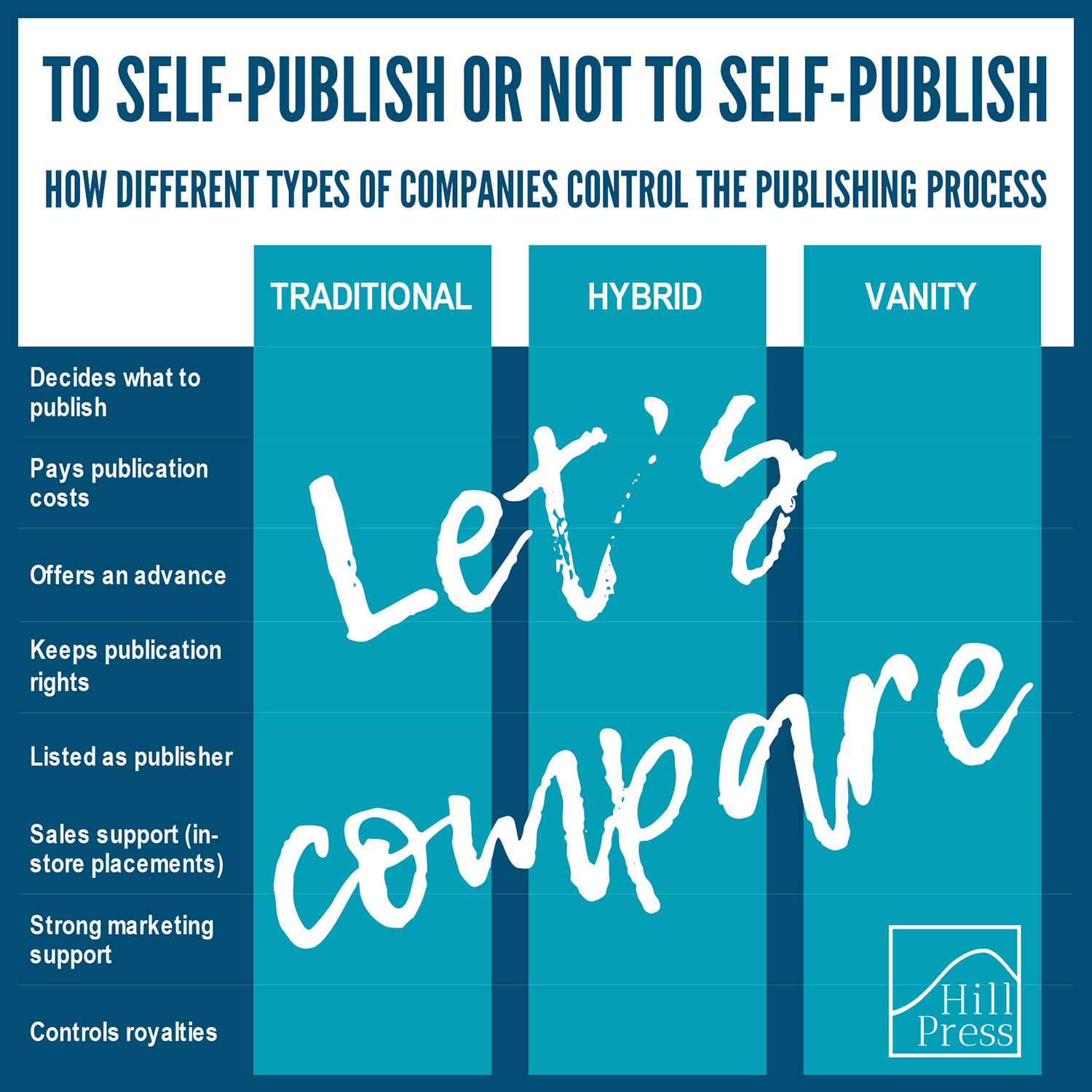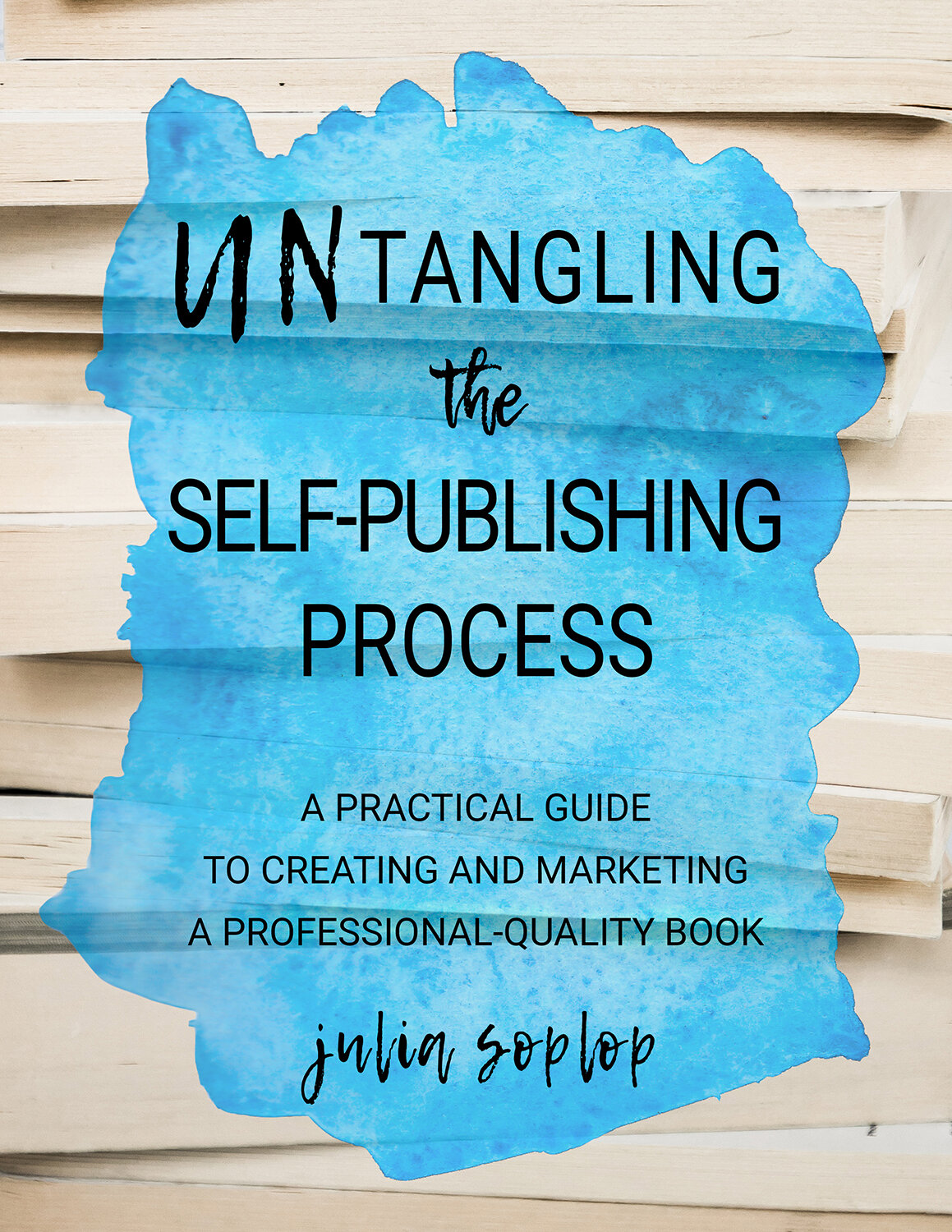To Self-Publish or Not to Self-Publish: Comparing Book Publishing Options
The following is an excerpt from Untangling the Self-Publishing Process: A Practical Guide to Creating and Marketing a Professional-Quality Book by Julia Soplop, Hill Press founder. Check out the ebook for further discussion on the pros and cons of traditional publishing vs. self-publishing, as well as an overview of the entire self-publishing process.
One of the first questions we often receive from authors is, “What are the publishing options for my book?” The answer is that there are numerous paths to consider, all with advantages and disadvantages, and it can take some time to determine the best one for you and your book. To help you get started, this post will define different publishing options (traditional, hybrid, vanity, and self-publishing); list distinguishing characteristics of each option; and offer a comparison chart.
Questions to Ask When Comparing Publishing Options
When determining which publishing avenue might work best for you, some of the most important questions to consider are:
Who decides what to publish?
Who pays publications costs?
Who offers an advance?
Who retains the publishing rights?
Who is listed as the publisher?
Is sales support for in-store placement provided?
Is marketing support provided?
Who controls and gets a slice of the royalties?
Book Publishing Options
Traditional Publisher
Traditional publishers have long acted as the gatekeepers of the literary world. They mostly include the Big Five: Penguin Random House, HarperCollins, Hachette, Macmillan, and Simon & Schuster. They all publish under many imprints, which are basically independent, themed brands. For example, Penguin Random House owns numerous imprints, such as Bantam, Ballantine, Three Rivers Press, Penguin Books, and Penguin Classics. The Big Five make up about 80 percent of the U.S. market for general interest trade books, like novels and nonfiction literature. Smaller, independent presses—meaning companies not associated with the Big Five—and independent, self-publishing authors make up the rest of the market.
Traditional publishers select the books they publish. They typically offer an author an advance of some level—usually a larger advance for an established author and/or a book expected to be hugely commercially successful. They cover production costs. They retain publishing rights to the book. They distribute the book and typically help to position it in brick-and-mortar stores. They may or may not provide some limited marketing support. (Unless the author is quite famous, splashy marketing campaigns are often the product of the author hiring a separate marketing firm.) Traditional publishers offer a percentage of the royalties to authors, but usually only once book sales cover the production costs of the book and the advance. Many authors never sell enough books to receive royalties. Traditional publishers used to employ offset printing—that is, the process in which inked images are transferred from metal plates onto rubber “blankets,” then onto paper—which can produce a higher quality print product. These days, however, many are turning to print-on-demand (POD), just like everyone else.
Hybrid Press
A hybrid press is just what it sounds like: a combination of traditional publishing and self-publishing. They select which books to publish, but their standards are likely much lower than a traditional publisher’s. You pay the production costs. You do not receive an advance. You may lose some editorial control. They retain publishing rights. They are listed as the publisher. A true hybrid press should offer you some level of distribution support, meaning they have a dedicated sales team positioning your book in brick-and-mortar stores. They offer you some level of royalties, keeping a percentage for themselves to cover their sales support. They may use offset printing or POD. They are unlikely to offer much marketing support.
Vanity Press
A vanity press is a configuration that many industry professionals caution against using. It can be difficult to distinguish between a vanity press and a hybrid press without reading the fine print. When a vanity press publishes your book, you pay the publishing costs. You do not receive an advance. You may or may not lose some editorial control. They retain the publishing rights. They are listed as the publisher. They upload your book to a wholesale distribution service (which you can do yourself), but they don’t have a sales team to position it in brick-and-mortar stores. They typically use POD. They often take a hefty portion of the royalties despite not doing distribution work themselves. They don’t usually offer marketing support.
Self-Publishing
Self-publishing means you control the entire publication process for your book. Authors who want to self-publish their work to retain editorial control and publishing rights but still produce high-quality books can hire professional publishing support services, such as editors, artists, book designers, and marketing professionals. These authors can then make their own choices about the self-publishing and distribution platforms they use and set their own list prices and wholesale prices. They can buy their own ISBNs and can create their own imprints.
Authors who want to put their work into the world but don’t have funds to hire professional publishing support services handle the entire editorial and design process, perhaps with the free assistance of family and friends. These authors can then make their own choices about the self-publishing and distribution platforms they use and set their own list prices and wholesale prices. They can buy their own ISBNs and can create their own imprints.
Hill Press
Hill Press is a mixed model. We offer editorial and publishing support services for independent authors, including a full range of editorial services, design referrals, and publishing consulting. These author clients retain their publishing rights and self-publish their books.
Separately, we have our own publishing arm. When we do publish books through our Hill Press imprint—our publishing brand or trade name—we pay the publishing costs, retain publication rights, and offer authors generous royalties. (We are not a vanity press!)
Publishing Comparison Chart
Below you’ll find a chart comparing types of publishing companies based on whether they decide what to publish, pay publications costs, offer an advance, keep publishing rights, list themselves as the publisher, provide sales support for in-store placement, offer strong marketing support, and control royalties. The offerings of individual companies and the ways those companies support individual authors may vary. For example, a traditional publishing company may offer some marketing support to celebrity authors but not much at all to non-celebrities. This chart depicts the trends.
There is no need to include self-publishing in the chart, because when you self-publish, regardless of whether you hire publishing support services or DIY, you incur all costs but also control the entire publishing process.
Want to learn more about what it takes to self-publish your book? Check out Untangling the Self-Publishing Process.



